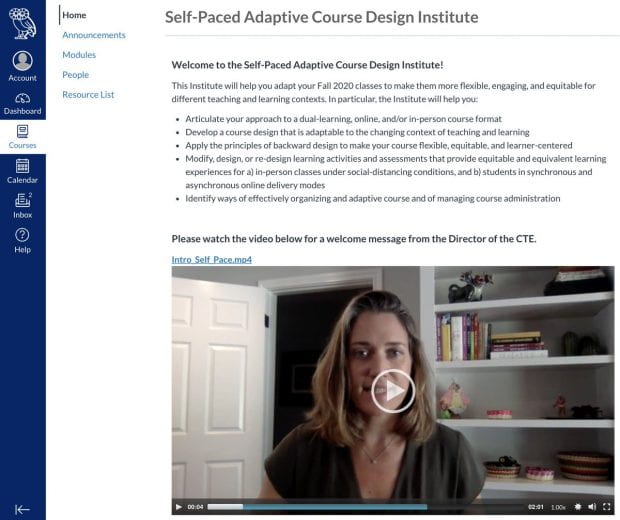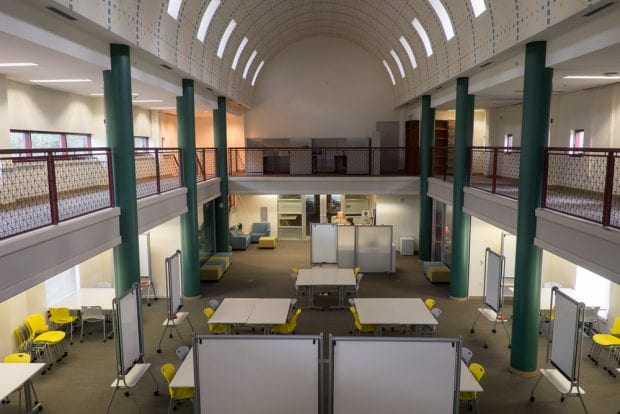Psychology professor Beier headlines Rice’s annual Center for Teaching Excellence symposium
The eighth annual Center for Teaching Excellence (CTE) symposium took a familiar form this year: a Zoom webinar. It was an apt adaptation for the yearly seminar, which typically takes place in person each spring, and a welcome chance for Rice professors to share what they’ve learned over two semesters spent teaching largely online.

Rice psychology professor Margaret Beier gave the keynote address at the eighth annual Center for Teaching Excellence symposium Jan. 15.
In fact, more people registered for the online symposium than for any of the prior seven, said CTE director Robin Paige. In preparation, the CTE staff worked with the CTE Faculty Fellows to organize a symposium that would achieve two main goals.
“To provide an opportunity for the Rice community to come together and share successes and lessons from teaching and working with students in 2020” was one goal, Paige said. The second: “To provide the opportunity for discussion and community-building as we move into our third semester teaching and working with students remotely or in dual delivery.”
Rice psychology professor Margaret Beier gave the keynote address at the Jan. 15 symposium. Informed by her own years of research into lifelong learning, Beier’s talk tackled evidence-based approaches to creating educational environments in which students can thrive. The basic tenets of teaching, Beier explained, remain the same regardless of whether content is delivered in person or online.
And learning, Beier reminded the audience, is a process — not just an outcome.
With that in mind, she began to break down the three basic determinants of learning: cognitive capacity, motivation and environment — all of which interact with each other.
‘Active learning techniques are more important now than ever before’
Cognitively speaking, Beier said, Rice students have a tremendous capacity for learning. But it’s crucial to recognize that any prior knowledge and skills they enter a class with can either help or hinder their progress.
“It’s important to level-set with your classes to understand where learners are so that you know what baggage they’re bringing with them and whether that’s going to help them or actually impede their learning,” Beier said.
And while lectures and assigned readings are popular, proven methods of increasing students’ knowledge and skills, she said, they’re also more “passive experiences.” Active learning experiences, by contrast, are more successful in online environments, where attention spans are more easily attenuated, making meaningful interactions with professors and peers more crucial than ever.
“I don’t think lectures are bad; I think they’re actually quite good and I engage in them a lot,” Beier said. “But if you’re on Zoom … I know it’s difficult for me to pay attention for more than 20, 30 minutes at a time, and it is difficult for students to pay attention too.”
Providing a “pre-test” with questions to listen for ahead of a lecture, asking students to create a “mind map” or visual summary following a video or simply requiring students to elaborate on what they’ve learned at the end of each class can “break up the passivity” of a lecture, Beier said.
“These types of active learning activities can be super interesting and fun for students,” she said. “And there’s brand-new research to suggest that these active learning techniques are more important now than ever before.”
Connecting with students’ motivation for learning is also more important than ever, especially when level-setting to find out their goals and values — and therefore what motivational “levers” can be successfully employed. Do they want to become a physician? Get an A in this physics course? Pass this next exam?
Many college students are self-directed learners whose values need to be engaged for the course to have maximum impact. Demonstrating the relevance of the course content to current events or students’ career aspirations are two means of engaging those values. Project-based courses are also highly influential.
“And what we found is that students who engage in even one of these project-based courses were more likely to — in their whole college career — more likely to have career aspirations in that content area than students who did not,” Beier said. “These project-based courses actually engage students in the activities of the profession, so it not only gives students some idea of how they might behave as professionals, it also gives them some experience as to whether they like it or not.”
‘Students are increasingly describing their isolation’
Beier defined the third determinant of learning — the environment or “climate” of a class — as the sum of student-instructor behaviors and student perceptions that influence the emotional and social experiences of a class. Obviously, online learning presents a drastically different climate than in-person teaching when it comes to both student-instructor interactions and student-student interactions, both inside and outside of class.
Combine these factors with established research that shows students are less engaged when professors present themselves as flippant, unapproachable or inattentive, and it’s easy to see how the naturally distancing medium of online learning can present complications to interpersonal communication.
Beier also referenced a qualitative study from the mid-1990s that demonstrated the importance of students interacting with each other.
“Students learn from one another, and they also build their networks through who they meet in school,” Beier said. “And so students are increasingly describing their isolation as a result of the pandemic. They’re feeling the anxiety that we’re feeling about safety and their own health and the health of their families.”
Heading into another semester of online learning, it’s vital to establish a supportive climate for students, she said.
This can be achieved through reviewing syllabi to ensure the language is less punitive and more constructive, for instance, or finding ways to integrate more study groups into classes that wouldn’t necessarily lend themselves to small breakout sessions. Require students to attend virtual office hours and praise them for doing so. Understand that they’re human beings in the process of discovering and establishing their identities as young people. Let students know that even if you can’t solve a problem for them, you can help connect them to a resource.
“It’s more important than ever, in my view, to establish a culture of care in our classrooms,” Beier said.

In addition to the symposium, the CTE continues to provide an array of resources to prepare for teaching this semester, including the well-received “Self-Paced Adaptive Course Design Institute” that Paige and the CTE staff designed for Rice instructors.
Following the keynote address, symposium attendees broke out into four sessions, each led by professors, on a variety of topics.
“I compiled a list of faculty who were nominated by their department chairs as well as students for doing an exceptional job teaching last semester,” Paige said of the selection process, which she made sure included instructors from a diversity of disciplines, course enrollment and modalities. “Every person I asked was eager to participate and share.”
“Building Connection with Students” was led by Jonathan Homola, assistant professor of political science; chemistry lecturer Carrie McNeil; anthropology lecturer Molly Morgan; and Sandy Parsons, associate teaching professor of psychological sciences.
“Creating Community Across Modalities” was led by bioengineering lecturer Sabia Abidi; Margarita M. Castromán , assistant professor of English; Program in Writing and Communication lecturer Burke Nixon; and Ray Simar, Professor in the Practice of electrical and computer engineering.
“Adapting Assessments and Feedback” was led by Don Johnson, the J.S. Abercrombie Professor Emeritus of electrical and computer engineering; Kristi Kincaid, associate teaching professor of chemistry; Natasha Kirienko, assistant professor of biosciences; and policy studies lecturer Paul Treacy.
“Balancing Flexibility, Expectations and Rigor” was led by Beth Beason-Abmayr, teaching professor of biosciences; Alex Byrd, Vice Provost for Diversity, Equity and Inclusion and associate professor of history; bioengineering lecturer David Li; and chemistry instructor Kasey Leigh Yearty.
In addition to the symposium, the CTE continues to provide an array of resources to prepare for teaching this semester, including the well-received “Self-Paced Adaptive Course Design Institute” that Paige and the CTE staff designed for Rice instructors. The CTE also offers a lengthy Adaptive Teaching Guide and one-on-one pedagogy consultations on adaptive strategies for dual delivery.
For more on this and other pedagogical support at Rice, visit cte.rice.edu.


